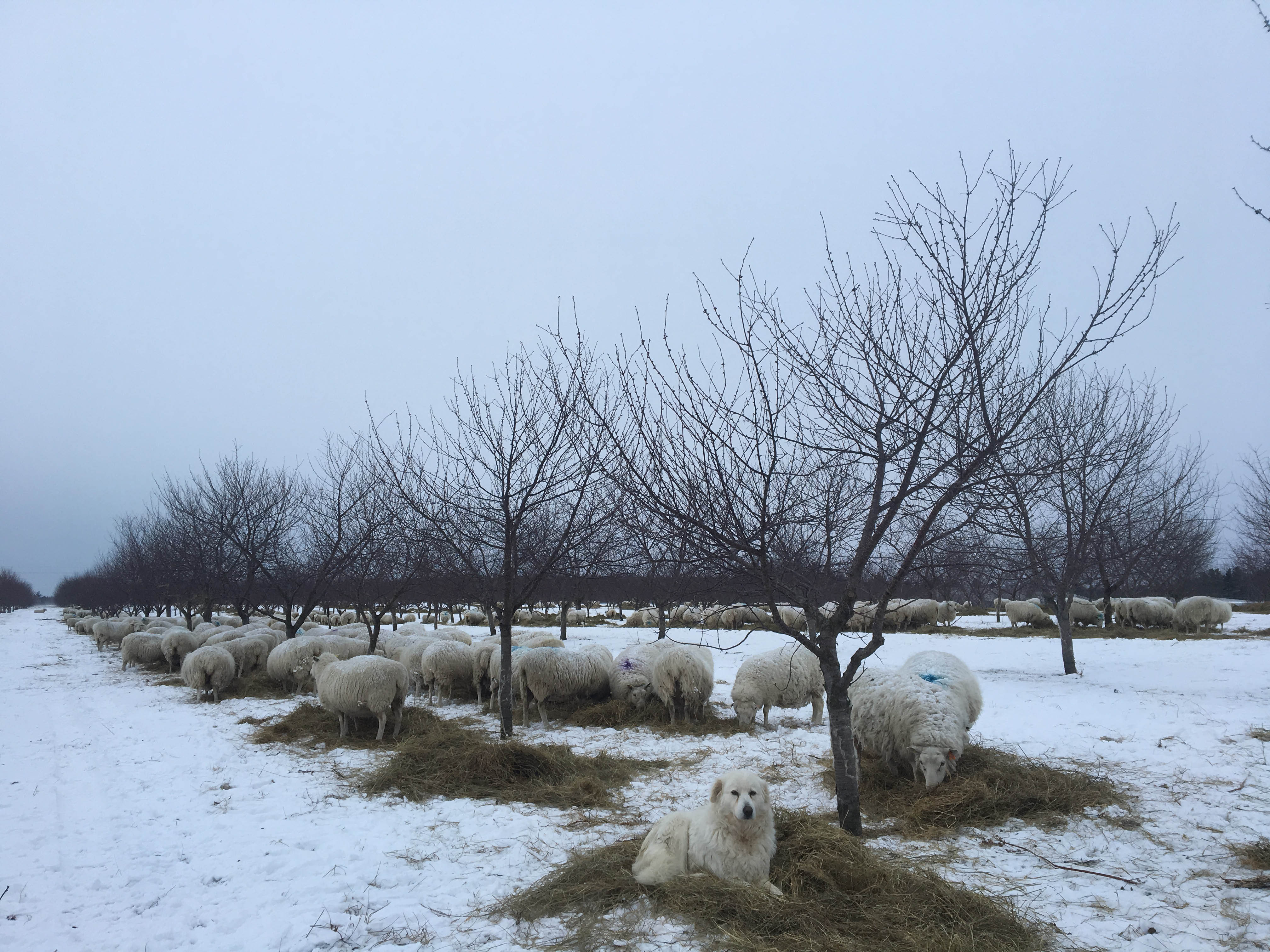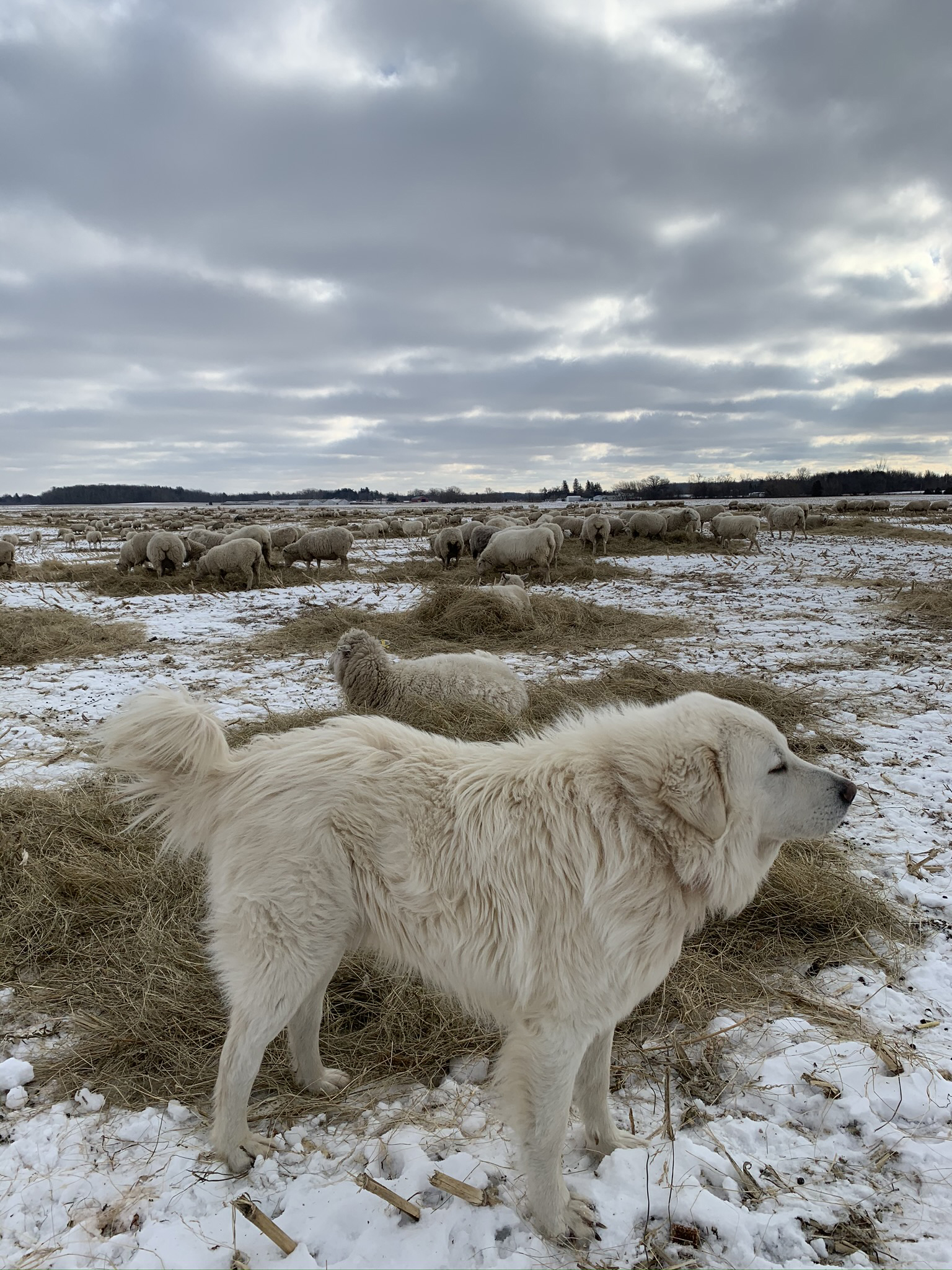Care and management
ISSN 1198-712X, Published March 2022
Overview
Livestock guardian dogs (LGDs) are dogs that are purpose-bred for living with the flocks they guard, to reduce predation
For hundreds of years, these rugged animals have lived outside with sheep, year-round, withstanding harsh elements (Figure 1). This fact sheet reviews considerations for the management and care of LGDs, with a focus on their care in winter.
These companion fact sheets provide further information for producers seeking to add LGDs to their operation:

Life of an LGD
An LGD is bonded to the flock it lives with and should want to stay with the ewes or does.
Shepherds say the dog thinks it is a sheep. Researchers believe the LGD is treating the sheep as if they were other dogs, and the sheep are treating the dogs as if they were other sheep
An LGD works a 24-hour day, alert to intruders. Often the dog’s mere presence in the area or simply a strong bark will derail a predator’s plans for the stock
These dogs are hardy animals and even during severe weather may choose to not enter shelters such as a doghouse or barn. They prefer to sleep where they have a full view of their surroundings and the sheep or goats. Pasture studies found that generally, at night, the dogs stayed within about 200 m of the food, water and bed grounds of the dogs and flock or herd
An average LGD will typically be most effective for about 5 to 6 years once reaching maturity. It’s important to note that the needs of the dogs will change overtime, and older LGDs may require more care to remain healthy and effective.
Handling cold, wind and rain
Breeds used as livestock guardians, including Great Pyrenees, Maremma, Komondor and Akbash, are hardy animals and even during severe weather may choose to not enter shelters such as a doghouse or barn
The common LGD breeds generally have a long, flat, weather-resistant outer coat that sheds water, and a thick, “downy” undercoat for warmth. Rough-coated, undercoated, short-eared dogs can withstand lower temperatures than smooth-coated, greyhound-shaped dogs.
Professors Ray and Lorna Coppinger studied 1,000 LGDs for over 10 years during the Livestock Dog Project
Large dogs have less trouble handling the cold of our winters than the heat of our summers
Shelter
Full-fleeced ewes that are healthy and properly fed can spend the winter outside without access to a barn. Stock and LGDs require a windbreak for very cold, windy days.
A windbreak may take the form of a bush that can be around the outside of the field to block the wind or in the field, allowing animals to enter it for shelter. Wooden windbreak fences looking like tall snow fences, or made of partially porous windbreak “cloth,” can provide adequate wind shelter for stock and the dog.
Sheep and goats will also use each other as shelter from the wind. When an animal on the windy side becomes cold, it moves and works itself into the centre of the flock or herd. LGDs will do the same, burrowing into the centre of the flock if they want to get out of the wind.
LGDs will lay in the fence row of a field, using the shrubs and snowbanks for shelter. Dogs have been seen lying on top of the round bales of hay in a feeder. If large round bales are unrolled for feeding, the dogs will lie on the hay.
Respondents to the Ontario LGD survey conducted through the Large Flock Operators (LFOs) working group in 2003 commented that their older dogs would seek shelter from the cold rain
Doghouses have been placed in summer pastures by Western U.S. open range ranchers (pasturing sheep in areas where there are no fences) to provide a home site and feeding station for the dogs. They place a salt lick on the back of the doghouse to attract the sheep to this area, so the doghouse becomes a socializing point for the sheep and dogs, helping to reduce roaming
LGDs are adaptive and can make changes to their routine as conditions change. In Ontario, LGDs are not tethered and can make their own choices and change their microclimate as the need arises. Using the same shelter as the stock it protects, a properly fed, well-conditioned LGD does not require a traditional doghouse.
Feeding
The nutrient demands of LGDs may vary depending on age, season and predation pressure.
Feed a quality dog food to maintain a moderate body condition score where dogs are neither too lean nor obese.
LGDs should not be allowed to scavenge on dead sheep and any farm-butchered meat must be cooked to an internal temperature of 72°C or frozen for a minimum of 10 days to prevent them from infecting livestock with parasites. “Sheep Measles” is caused by an intermediate stage of Taenia ovis, which is a tapeworm that affects dogs
According to the LGD owners survey, shepherds increased the amount of feed offered to the dogs during extremely cold weather and/or increased the fat/energy content of the feed during the winter months.
Some sheep producers have self‑feeders available for the dogs, allowing the dog to decide if and when it requires more feed. However, this feeding strategy can attract vermin and substantially increase feed costs
Considerations
Since these dogs often choose to stay outdoors in all weather conditions (Figure 2), their metabolic action may increase in response to severe weather, causing them to need more feed. One dog food manufacturer suggests that dogs need about 7.5% more feed for every 5.5°C drop in temperature, once the temperature reaches the point where the LGD is shivering or trying to avoid the cold
When coyotes are pressuring a flock and “working” the LGDs, the dogs often lose some weight. Some shepherds change dog feed to a higher energy feed during these times of the year.
The National Research Council reported in Nutrient Requirements of Dogs that “Requirements for work and adverse environmental conditions make a... systematic schedule for meeting such diverse requirements impractical. Thus, it is recommended to feed to thrifty body condition... a reliable sign of uncomplicated energy deficiency is generalized loss of bodyweight.”

Especially during harsh weather, check the body condition of your LGDs
Veterinary care
The LGD must be part of the flock or herd health plan, both for its own health and the health of the stock.
Work with your veterinarian to develop routine veterinary care protocols
- a deworming strategy, to reduce the risk of carcass condemnations in the flock
- strategies for managing other parasites (such as heartworm, fleas and ticks)
- recommended vaccinations for the health of the LGD
footnote 31
In Ontario, all dogs over 12 weeks of age are required to be vaccinated against rabies according to O. Reg. 567 (Rabies Immunization) under the Health Protection and Promotion Act. Your veterinarian may recommend additional vaccines based on the risk of exposure to other pathogens.
Conclusion
LGDs are hardy breeds that are well suited to the Ontario climate but may need additional care during the winter months.
The LGD prefers to be with the flock or herd it protects and use the same shelter as the stock, adjusting its routine as conditions change.
The LGD should be:
- fed to maintain appropriate body condition
- receive routine veterinary care for both its own health and the health of the flock or herd
Overall, LGDs are a valuable tool in the flock or herd predation strategy but need appropriate shelter, feed and care to be effective at their job.
This fact sheet was written by Barry Potter, agriculture development advisor, OMAFRA, Craig Richardson, animal care specialist (retired), OMAFRA, and Christoph Wand, livestock sustainability specialist, OMAFRA.
Footnotes
- footnote[24] Back to paragraph Coppinger, L. and Coppinger, R. (2014). Dogs for herding and guarding livestock. In T. Grandin (Ed.), Livestock Handling and Transport, 4th Ed. (pp. 245–260). CAB International.
- footnote[25] Back to paragraph Coppinger, R., Coppinger, L., Langeloh, G., Gettler, L. and Lorenz, J. (1988). A decade of use of livestock guarding dogs. Proceedings of the Thirteenth Vertebrate Pest Conference (1988), 43, 209-214.
- footnote[26] Back to paragraph Lorenz, J. and Coppinger, L. (2002). Raising and training a livestock-guarding dog. Oregon State University Extension Service. (Original work published in 1996).
- footnote[27] Back to paragraph Linhart, S.B., Sterner, R.T., Carrigan, T.C. and Henne, D.R. 1979. Komondor guard dogs reduce sheep losses to coyotes: A preliminary evaluation. Journal of Range Management 32(3): 238–241.
- footnote[28] Back to paragraph Andelt, W.F. (1992). Effectiveness of livestock guardian dogs for reducing predation on domestic sheep. Wildlife Society Bulletin, 20(1), 55–62.
- footnote[29] Back to paragraph Coppinger, L. and Coppinger, R. 1980. So Firm a Friendship. American Museum of Natural History. 89: 12–26.
- footnote[30] Back to paragraph Richardson, C. 2003. Ontario Large Flock Operators livestock guardian dog questionnaire. Ontario Ministry of Agriculture, Food and Rural Affairs.
- footnote[31] Back to paragraph Redden, R.R., Tomeček, J.M. and Walker, J.W. (2015). Livestock guardian dogs. Texas A&M AgriLife Extension Service, 1-8.
- footnote[32] Back to paragraph DeWolf, B.D., Peregrine, A.S., Jones-Bitton, A., Jansen, J.T. and Menzies, P.I. (2014). Taenia ovis infection and its control: a Canadian perspective. New Zealand Veterinary Journal, 62(1), 1–7.
- footnote[33] Back to paragraph The Purina Pet Care Center. 1992. Cold weather care of dogs. Nestle Purina.
- footnote[34] Back to paragraph National Research Council Subcommittee on Dog Nutrition. 1985. Nutrient requirements of dogs, Revised 1985. The National Academies Press.
- footnote[35] Back to paragraph Nestle Purina Pet Care Centre. (2021). Body condition system: Where do you think your pet scores?